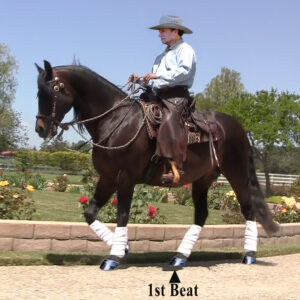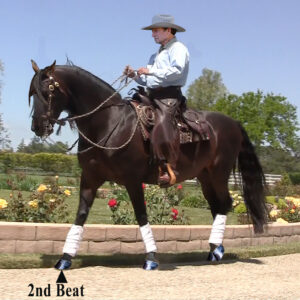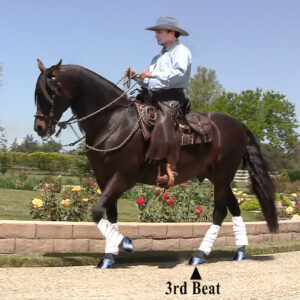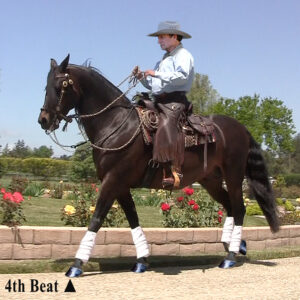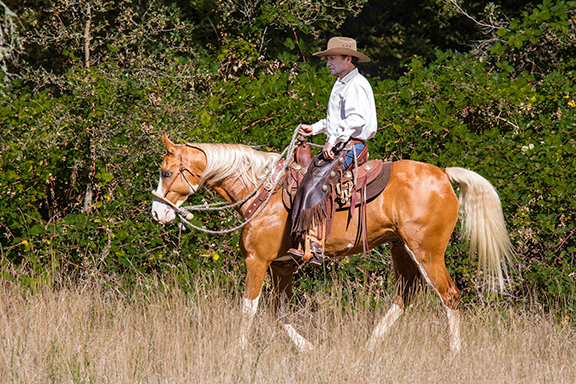The Queen of Gaits: The Walk
Within equestrian tradition, the walk has always deserved to be called the “queen of gaits” because of the benefits that both horse and rider can derive from this gait. The walk is the gait of choice not only when teaching the horse something new but also in confirming and improving already trained movements.
The gait most often neglected in the training of our Western horses—is the walk. The balanced walk is a four-beat gait requiring even distribution of the horse’s weight between all four feet as he carries his weight forward. The footfall pattern of the walk is left hind, left front, right hind, right front. A single stride of the walk includes movement of all four feet beginning with the left hind and ending with the right front.

Fig 1. The four-beat gait of the walk, beginning from the left hind: The footfall pattern is left hind, left front, right hind, right front. If
the horse has stopped square he
will always initiate the walk from the hindquarters, pushing himself forward into the gait. The first foot to move is the front foot to catch the balance as the horse moves forward. Therefore, the hindquarters drive the horse forward in the walk, and the forehand balances him.
(fig.1). Because the rider’s body moves side to side in a two-count rhythm as her horse is moving in a four-count rhythm below, the walk is often counted with the steps of either the front or the hind feet. While technically incorrect to count steps rather than strides of the walk, it can be useful to begin both to get in time with the horse, as well as learn where the horse’s feet are as step.
Engagement and Disengagement
Understanding the walk by its essential parts of the stride can help you learn to identify, and thereby feel, where the feet are at any given time during the motion of the stride. The stride is composed of weight-bearing and non weight-bearing (flight) phases, which at the walk happen independently for each foot. Both the horse’s head and hip shift in balance with the weight-carrying phase of the hind feet(fig.2).

(fig.2) – Engagement is the phase of the stride that is actively pushing the horse forward. The engaged phase of the stride happens under the horse’s body. By increasing engagement in the stride, you are improving the quality of movement, the balance, and forward drive of the stride.
We define Engagement in the stride as the forward weight-bearing phase. In the hindquarters this phase happens from the moment the horse’s foot becomes weight-bearing under the body of the horse to the moment it passes under the hip of the horse on its way to the flight phase. As the horse steps into engagement in the hindquarters, the horse pushes forward and the head goes up.
(fig.3).
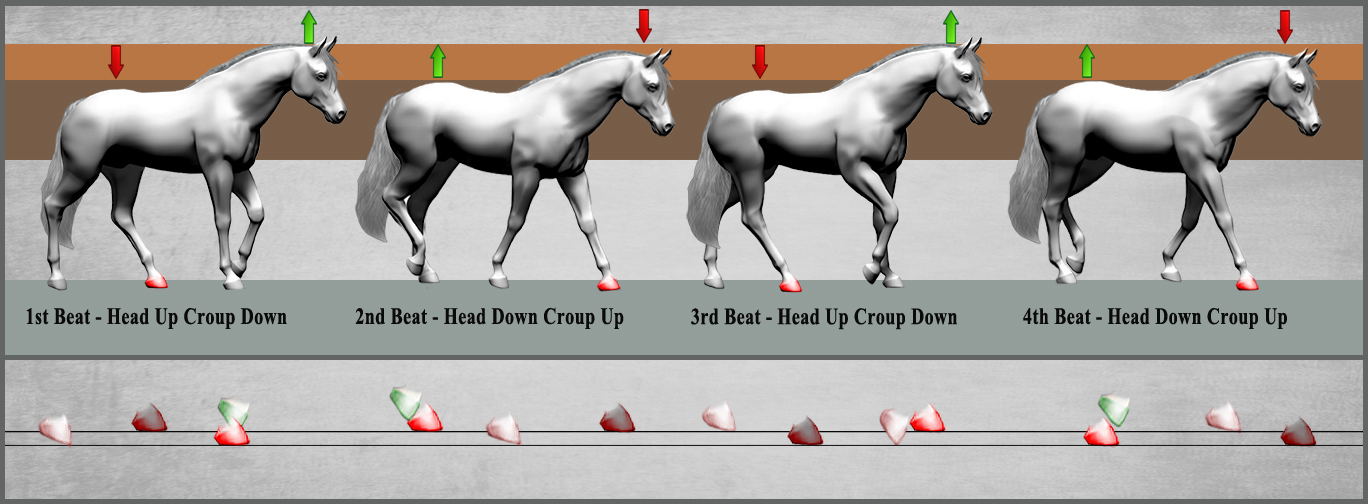
(fig.3). The movement of the horse’s head can tell the rider where the feet are. The head bobs like a counterweight as the horse’s weight shifts from the front to back in time with the footfall. The horse’s head will rise as the horse shifts his weight to the hindquarters driving forward in engagement. This is also the point at which the front foot strikes the ground. The head will bob down as the horse shifts his weight to the forehand.
Disengagement is defined as the portion of the gait when the horse’s leg is behind the hip as it enters the flight portion of the stride. As the horse shifts the weight of the hindquarters to the forehand, the head goes down. Therefore, as the left hind leg pushes forward, the head is up until the left hind is at the end of its weight-bearing phase, and then in its disengagement phase, shifts the weight to the horse’s left foreleg, causing the head to go down.

(fig 1.1). The four-beat gait of the walk, beginning from the left hind: The footfall pattern is left hind, left front, right hind, right front.

(fig 1.2). While only the jog is considered a true diagonal gait, each of the gaits share a diagonal component pattern in the footfalls.
In the walk, the diagonal movement happens once in each stride as the weight is shifted from the 2nd beat to the 3rd beat. As the stride is completed, the diagonal weight is transferred again from the 4th beat back to the 1st beat.
Another technique for getting into time with the horse’s hind feet is to feel the rolling of his ribcage underneath you. When your legs are lying along the horse’s sides in gentle connection with the horse, you can feel the horse’s rib cage moving between your calves. As the horse lifts the hind end and steps with the left hind foot, the barrel will roll to the right. The rider riding in time with the horse will also feel the rhythm of the walk on the seat bones.
(Fig.4).
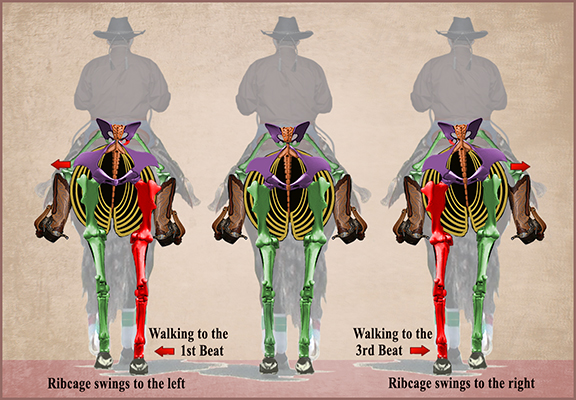
(fig.4) Another technique for getting into time with the horse’s hind feet (foot falls) is to feel the rolling of his rib cage underneath you. When your legs are lying along the horse’s sides in gentle connection with the horse, you can feel the horse’s rib cage moving between your calves. As the horse lifts the hind foot and steps forward, the rib cage will roll to the side. The rider riding in time with the horse will also feel the rhythm of the walk on the seat bones.
Working Walk
The working walk is the very foundation of all
the work that we do in Cowboy Dressage and
is the framework for introducing Soft Feel and self-carriage.(fig.5).
In the working walk, the horse moves with the rider in a softened and slightly shortened frame. It is important to carry the energy of the walk into the working frame
so that the gait retains a snappy energy without becoming sluggish. In the working frame, the horse carries his head and neck in a position to encourage shifting of the center of gravity back- ward toward the hindquarters with softening of the poll, relaxation of the jaw, and elevation of the withers from the shoulder.
Teaching the horse to develop a good walk begins on the ground. You can teach the horse to respond to the energy in your body language through your groundwork—lengthening and shortening the stride at the walk. Groundwork exercises are a very important part of creating a good walk once the rider is aboard. The walk is also one of the best gaits to warm up the horse’s joints and muscles before moving up to faster gaits.
Use your walk wisely in your schooling because failing to build a good walk as a fundamental gait in your horse is something that is difficult to rebuild later down the road in your training. The walk is the alphabet in learning to read.
Free Walk
The free walk is the four-beat walk in the horse’s lengthened frame (fig.6).
It can be used as a reward to the horse after periods of working or time spent in a short frame, or when the horse has been asked to do something difficult men- tally or physically. Because the muscles of balance are smaller and weaker than the muscles of extension in the top line, those muscles become fatigued more quickly and require periods of rest and stretching in order to be developed to their maximum potential. The free gaits, especially the free walk, allow the horse the opportunity to relax and stretch the muscles of extension and allow for a recovery period for the muscles of flexion.
Colonel Christian Carde shares this classical approach to training the horse. “What is the cause of the ruined walk and where does the evil have its roots? Undoubtedly, in a hard, backward-operating hand that leads to an equitation where forced submission dominates and the horse is ridden from front to back.
When, for example, in the extended walk, the hand is not following the natural head–neck movement of the horse, but instead constrains it, the horse’s neck cannot be used effectively, with the consequence of the walk getting irregular. When the walk’s four-beat rhythm is disturbed, the horse cannot swing over the back, so he stiffens it. Moreover, horses ridden that way have no faith in the rider’s hand and do not stretch out, but sometimes curl away from the bit or get behind it.
As a principle, one can claim that if the mouth of the horse is not relaxed, the rest of his body isn’t. So when riders ask me how to fix such problems, there’s no other recipe than going back to the basics.
To solve problems in walk, the rider first needs to focus on getting a proper contact through working the horse from the back to the front and relaxing the horse’s mouth through gymnastic exercises. This is neither easy nor done in a short time as it means changing a whole concept of equitation, which might be the reason why some riders would rather live with bad marks in the walk than get to the root of the trouble. I should mention that a few riders do know how to use the walk as a tool to improve the whole horse, but working him in walk has regrettably gone out of fashion.
For those who are willing to improve the walk and, above all, the whole horse, it’s invaluable to use this slow gait to make the horse supple and flexible and, at the same time, work to get a soft, permanent contact”.
Read more at: Dressage the Cowboy Way
THE COMPLETE Guide to Training Riding with Soft Feel and Kindness. Paperback – Eitan’s new Book Coauthored by Jenni Grimmett DVM. http://cowboydressage.com/storefront.html
![]()

